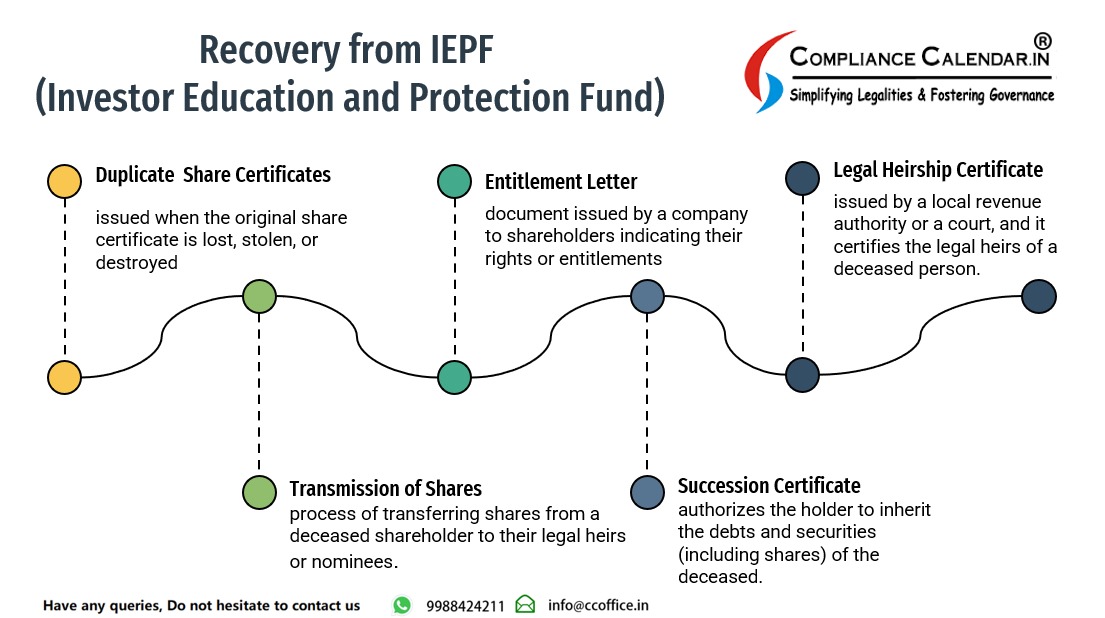
The Investor Education and Protection Fund (IEPF) was established by the Government of India to safeguard the interests of investors. It collects unclaimed dividends, matured deposits, debentures, and shares that have remained inactive for seven consecutive years. If you have Claim shares transferred to the IEPF, you can claim them back by following the right procedure.
Understanding IEPF and Its Role
IEPF functions under the Ministry of Corporate Affairs (MCA). It was created to promote investor awareness and refund unclaimed investments. When shares or dividends remain unclaimed for seven years, companies transfer them to the IEPF, as per Section 124 of the Companies Act, 2013. The fund not only holds these assets but also allows rightful owners to reclaim them.
Reasons for Shares Being Transferred to IEPF
- Unclaimed Dividends: If dividends remain unclaimed or unpaid for seven years, the corresponding shares are moved to IEPF.
- Inactive Accounts: Shareholders who don’t update their contact details or fail to respond to company communications risk their shares being transferred.
- Loss of Physical Share Certificates: Misplaced or lost share certificates can result in shares going unclaimed.
- Change in Address Without Notification: If a shareholder moves and doesn’t inform the company, they might miss important updates about their shares.
- Step-by-Step Procedure to Recover Shares from IEPF
Recovering shares from IEPF involves a structured process. Here’s how you can claim your shares:
-
Gather Required Documents:
-
Original share certificates (if available).
-
Proof of identity (PAN Card, Aadhaar Card).
-
Proof of address.
-
Client Master List (CML) from your Demat account.
-
Canceled cheque leaf with your name printed.
-
Dividend warrants (if any).
-
Indemnity bond and advance stamped receipt.
-
-
Filing Form IEPF-5:
-
Visit the IEPF portal on the MCA website.
-
Download Form IEPF-5 and fill in the necessary details like personal information, company name, and number of shares.
-
Attach scanned copies of the required documents.
-
Submit the form online and save the acknowledgment receipt.
-
-
Sending Physical Documents to the Company:
-
After submitting Form IEPF-5, send the acknowledgment along with self-attested copies of the documents to the Nodal Officer of the company.
-
Include an original indemnity bond and an advance stamped receipt.
-
-
Verification by the Company:
-
The company verifies the documents and forwards them to the IEPF Authority within 15 days of receiving them.
-
If discrepancies are found, the company may ask for additional information.
-
-
Approval by IEPF Authority:
-
The IEPF Authority reviews the application and, if satisfied, approves the claim.
-
Once approved, the shares are transferred to the claimant’s Demat account.
-
Common Mistakes to Avoid
-
Incorrect or Incomplete Forms: Ensure all details in Form IEPF-5 are accurate.
-
Missing Documents: Submit all required documents to avoid delays.
-
Delays in Sending Physical Documents: After online submission, send physical copies promptly.
-
Unclear Communication with Companies: Maintain clear communication with the company’s Nodal Officer for updates.
Timeframe for Recovery
The entire process usually takes 3-6 months, depending on the accuracy of the documents and the efficiency of the company and IEPF Authority. Timely submission and accurate paperwork can speed up the process.
Points to Remember
-
Always keep your contact details updated with the company to avoid shares being transferred to IEPF.
-
Regularly monitor dividend payments and shareholding status.
-
Store share certificates and related documents safely.
Legal Provisions Related to IEPF
-
Section 124 of the Companies Act, 2013: Deals with unclaimed dividends.
-
Section 125 of the Companies Act, 2013: Establishes the IEPF and outlines its functions.
-
IEPF Authority (Accounting, Audit, Transfer, and Refund) Rules, 2016: Provides detailed procedures for transferring and reclaiming shares.
Conclusion
Recovery of shares from IEPF might seem tedious, but with proper documentation and timely actions, the process becomes manageable. Staying proactive with your investments, keeping your details updated, and promptly addressing any issues can help prevent your shares from being transferred to the IEPF in the first place.
Comments on “Recovery of shares from IEPF in India”